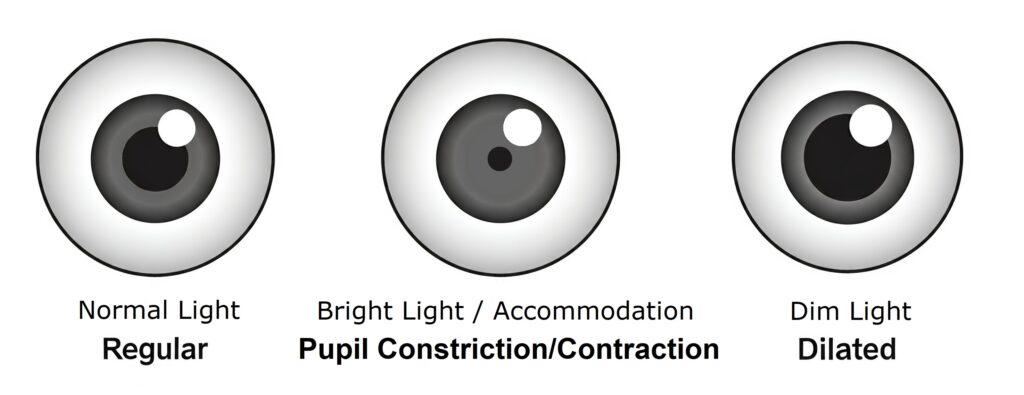“Can I NOT have my eyes dilated today?” This is a common question with many online articles. Yet, people continue to ask it, and, therefore, others, including us, continue to give updates on this topic. As recent as August, the NY Times posted an article titled “Do You Really Need Dilation at Every Eye Exam?“
What is a Dilated Eye Exam?
Normal adult pupils contracts to 2~4mm in diameter in response to bright light and dilates to 4~8mm in the dark. In addition, the pupils constrict to increase depth of field to focus on near objects, aka accommodation.
During a comprehensive eye exam, eyedrops are used to pharmacologically enlarge the pupil sizes. This painless procedure allows for a wider and clearer view of the structures inside the back of the eyes. The dilated pupils are temporarily relaxed and cannot respond to light stimulus nor accommodate. This results in visual discomforts, most notably blurred vision, trouble focusing on close objects, and heightened sensitivity to light. This effect cannot be medically reversed and usually relieves in 3 to 8 hours.

The Importance of a Dilated Eye Exam
Eye doctors often compare the pupil to the aperture on a camera or a door to explain dilated eye exams.
- Undilated Pupil: This is like looking through a tiny peephole into a dark room. The amount of light entering and the range of view are both limited. Therefore, it’s difficult to see the details of the whole room.
- Dilated Pupil: This is like a door wide open. It allows the doctor to see the entire room, including any potential issues or problems that might be hidden.
Pupil dilation helps eye doctors see inside the eye, including the retina, optic nerve, macula, and blood vessels. This allows for early detection of eye diseases like glaucoma, macular degeneration, diabetic retinopathy, and hypertensive retinopathy among others. There are also over 250 systemic diseases that have ocular and visual manifestations. These changes often precede or occur concurrently with various systemic conditions, which may be subjectively symptomatic or asymptomatic.
- Viewing through a dilated vs undilated eye is like looking through an open door versus through a small window or hole.
Key Points from the NY Times Article:
| Key Point | Summary |
|---|---|
| Who Needs Dilation? | People with symptoms or risk factors, such as diabetes, high blood pressure, or family history of eye disease. |
| Optometrist’s Recommendation | Annual dilated exams for all adults, regardless of symptoms or risk factors. |
| Ophthalmologist’s Recommendation | Less frequent dilated exams for young, healthy adults without symptoms or risk factors. |
The AO Bottom Line
At Associate Ophthalmologists, we pride ourselves as trusted medical professionals and guardians for the well-being of our patients. While we understand the arguments presented in the article, we prioritize our patients’ eye health above all else. While rare, we can’t ignore the possibility of overlooked issues in young, healthy adults. Visit our clinic for comprehensive health assessment today.
If you found this information helpful, please share with your friends and family.
Get in touch
We’re here to answer your questions and listen to your suggestions.
- Categories
- News (23)
- Tips (14)
- Uncategorized (1)